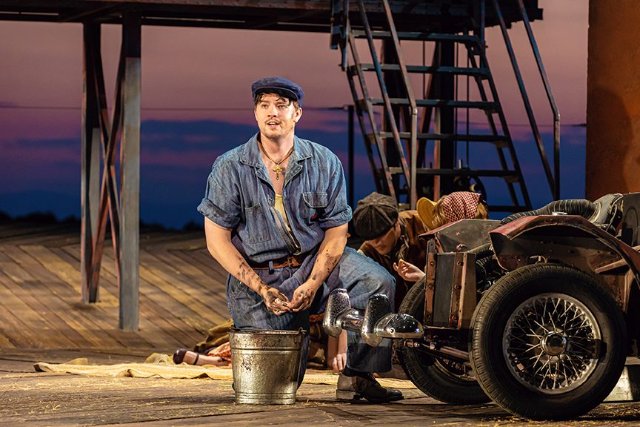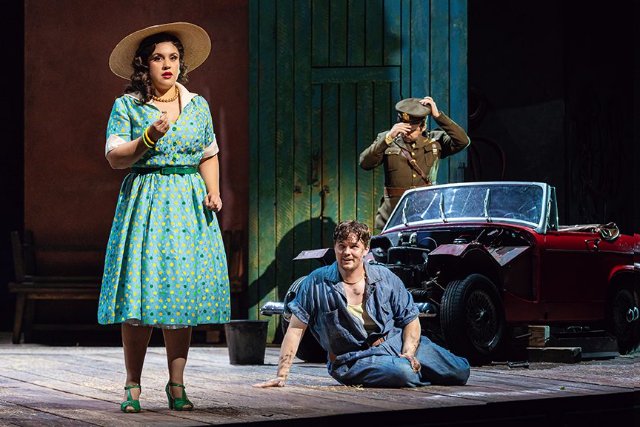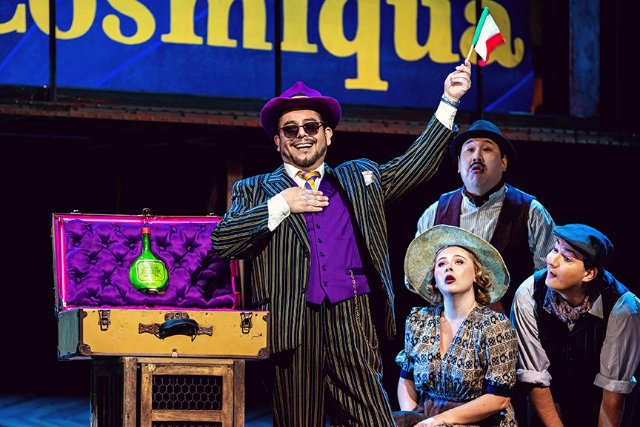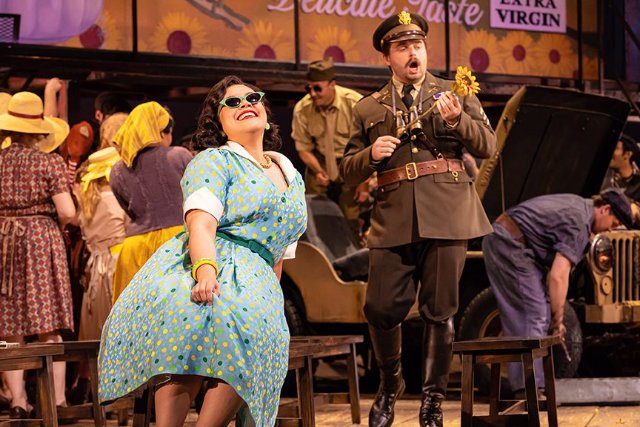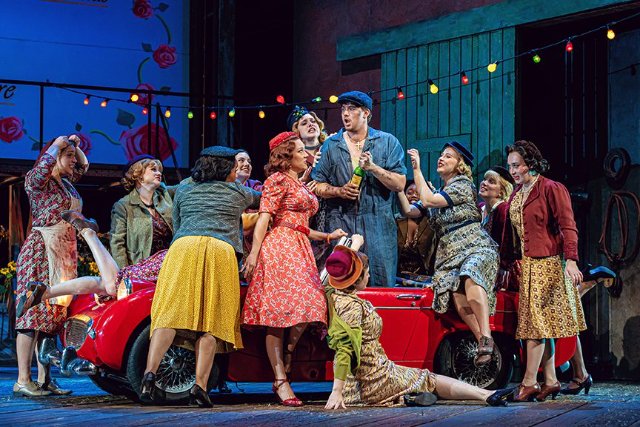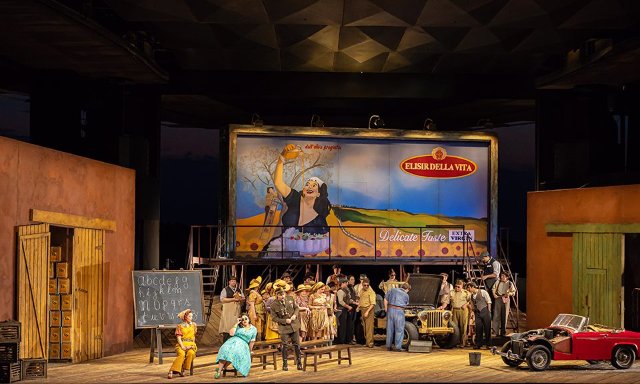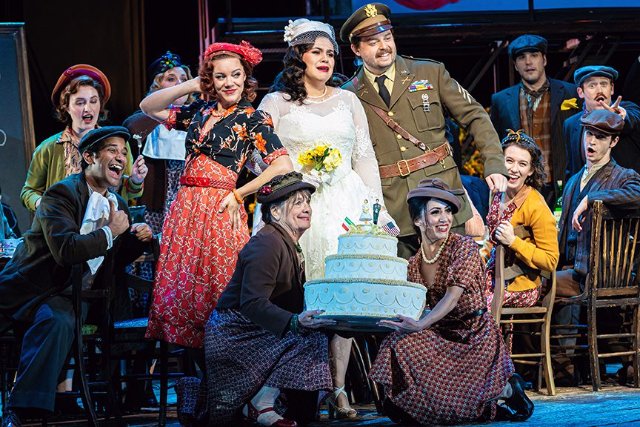The Elixir of Love
Donizetti's Frothy Comedy at Santa Fe Opera
By: Victor Cordell - Aug 15, 2024
Rarely has an opera composer moved with equal facility between dramatic and comedic genres. Gaetano Donizetti fills that role. Along with the brooding “Lucia di Lammermoor” and his three dark and tense Tudor-period operas, he wrote the music for “Don Pasquale,” “Daughter of the Regiment,” and “The Elixir of Love,” the last of which is offered in a bubbly and endearing production by Santa Fe Opera.
Especially with war horses of the opera repertory, companies are often loathe to present the same formula for each production. Although the underlying substance of the action remains unchanged, this Santa Fe version is brought into the 20th century. The central character Nemorino is still a peasant, but now an auto mechanic, while Belcore, his competitor for the hand of land owner and olive oil maker Adina, is a sergeant in the US Army stationed in Italy.
Although this bel canto confection comes from 1832, early in Donizetti’s career, the music is mature and constantly engaging with hummable melodies. With the exception of poignant moments of reflection, the score bounces with playfulness and humor throughout. Considering that the plot concerns a love triangle as well as the involvement of a love potion and its hawker, the libretto is remarkably efficient with only five principal parts.
The beauty of the music springs forth from the outset as Nemorino sings of gorgeous Adina in ‘Quanto è bella’ (How beautiful she is) in which he also reveals his self-doubt. Rising star Jonah Hoskins is the ideal Nemorino, having s supercharged tenor with an Italianate lilt and urgency ideal for this role. He also conveys the appropriate youthful innocence and the moxie to compete for a belle well above his station, most unlikely to succeed in the opera’s time and place. But this is a comedy!
The elixir of the title is introduced by Adina from literature. She reads aloud of a love potion employed by Tristan in “Tristan and Isolde” and sings her lovely first aria, ‘Della crude Isotta’ (From the cruel Isolde). Another notable young artist, Yaritza Véliz, performs as Adina. A fine fit for her counterpart, she mixes taunting condescension and convivial flirtation in tempting the hormonal Nemorino. Véliz’s strong soprano voice demonstrates passion and beauty, in addition to great flexibility in the lovely duet with Nemorino, ‘Chiedi all’aura lusinghiera’ (Ask the flattering aura).
Nemorino’s declaration of love for Adina is unsurprisingly rebuffed. But when “medicine man”/flim-flam artist “Doctor” Dulcamara arrives selling a potion that solves everything from lumbago to sexual appeal, Nemorino sees his solution in a shot of courage. As one would expect, Dulcamara is as evasive as he is effusive, but he assures Nemorino that the potion will make him irresistible. Alfredo Daza portrays the fast talker with zest and plenty of opportunity to display his formidable patter.
Meanwhile, conceited Belcore (Luke Sutliff) has proposed marriage to Adina. Like Daza, Sutliff gets to show his comic chops, but he also sings with distinction in a style with varying vibrato that could sometimes be characterized as coloratura, if that term were ever applied to a baritone.
Comic tension is maintained throughout as Adina gives out conflicted messages and actions and is even seeking revenge against Nemorino by agreeing to marry Belcore. Finally, the worm turns, and Nemorino knows that Adina loves him, revealed in the opera’s hallmark, the mournful tenor aria ‘Una furtiva lagrima’ (A secret tear). As in several other arias, the artist is able to show bel canto virtuosity, in this case, milking pauses for emotional effect. Hoskins offers a masterful rendition.
Although much of the narrative is driven by two-way exchanges between characters, the ambiance is kept lively with the almost constant presence of some level of choristers playing various crowd roles, singing as backup to principals, or singing dedicated chorus pieces. Since the chorus is comprised of the company’s vaunted apprentices, its voices are uniformly outstanding. But what makes it outstanding as a chorus is great balance and precise unison of voices, despite the individuals not being professional choristers. The credit for this excellence goes to Chorus Master Susanne Sheston, who is responsible for the choruses of all five summer productions.
A comedy demands a happy ending, and as expected, Nemorino and Adina get together. What does create a bit of unneeded moral qualm is that the protagonist’s uncle has died, making Nemorino wealthy, undermining the notion that a ‘rich girl could fall for a poor boy’ (with a bow to Jay and the Americans’ song ‘Only in America’). That said, is it possible that Adina was the only woman in town to not know of Nemorino’s fortune? But how realistic is that?
“The Elixir of Love” is one of opera’s most produced works and with good reason. Its blend of exquisite music with laugh-out-loud humor is par excellence. Santa Fe Opera’s production makes the best of a good thing.
“The Elixir of Love,” composed by Gaetano Donizetti with libretto by Felice Romani is produced by Santa Fe Opera and plays on its stage at 301 Opera Drive, Santa Fe, NM through August 22, 2024.

